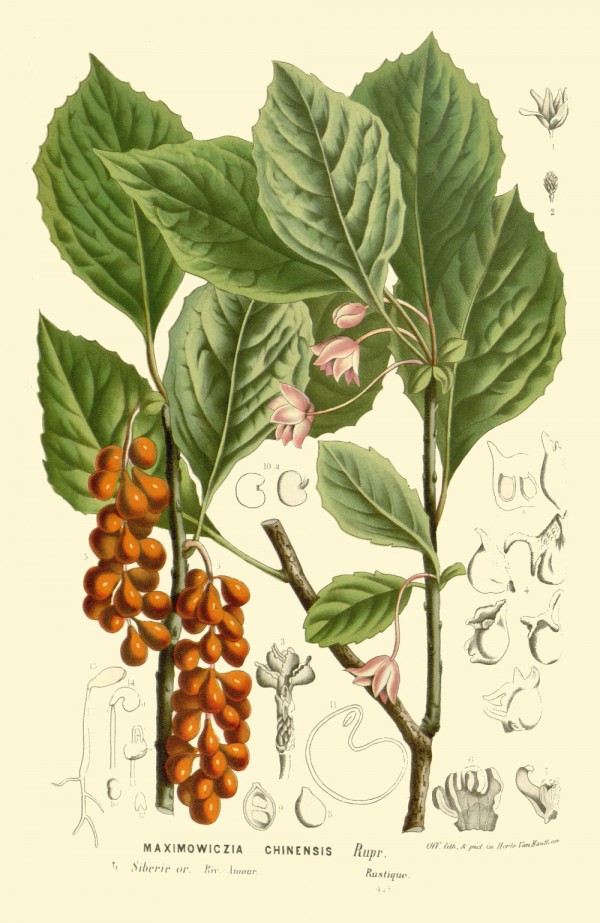Schisandra chinensis (Turz.) Baill. - syn.Kadsura chinensis Turcz.; Maximowiczia amurensis Ruprecht - Schisandraceae
五味子 wǔ wèi zi (chin.), 오미자 omija (kor.), five flavor berry, Chinese magnolia-vine, Chinesisches Spaltkörbchen, Chinesischer Limonenbaum
Deciduous dieocicous woody vine, nativ to northern China, Korea, Japan; leaves elliptic to obovate, denticulate to serrulate; flowers solitary, flowers are white or slightly cream-coloured, wax-like, with a pleasant smell; fruits pinkish red to red.
„This species is a horticultural plant with edible fruit. It is used medicinally and for making rope.“
http://www.efloras.org/florataxon.aspx?flora_id=2&taxon_id=200008486
„Its Chinese name comes from the fact that its berries possess all five basic flavors: salty, sweet, sour, pungent (spicy), and bitter. Sometimes it is more specifically called běi wǔ wèi zi (Chinese: 北五味子); literally „northern five flavor berry“) to distinguish it from another traditionally medicinal schisandraceous plant Kadsura japonica that grows only in subtropical areas.“ http://en.wikipedia.org/wiki/Schisandra_chinensis
„By steam hydrodistillation, the dried fruits of S. chinensis yielded 0.68% (v/w) of essential oil… Compounds 1,7-dimethyl-7-(4-methyl-3-pentenyl)-tricyclo[2.2.1.0 (2,6)]heptane (18.06%), 1,2,3,4,4a,5,6,8a-octahydro-7-methyl-4-methylene-1-(1-methylethyl)-naphthalene (15.58%), 2,4a,5,6,7,8-hexahydro-3,5,5,9-tetramethyl-1H-benzocycloheptene (11.45%), 1-methyl-4-(1-methylethyl)-1,3-cyclohexadiene (9.90%), (R)-1-methyl-
4-(1,2,2-trimethylcyclopentyl)-benzene (9.13%), were the major components of the oil of S. chinensis,…
Only three constituents (copaene, α-santalol and α-caryophyllene) of the thirty-nine compounds identified in
S. chinensis previously were found in this study (Zhu et al., 2008). In Zhu’s study, ylangene, 2,6-dimethyl-bicyclo[3.1.1]hept-2-ene, 3-methanlo, 1-methyl-8(1-methylethyl)-tricyclo[4.4.0.02,7]dec-3-ene were determined as major components of the essential oil obtained from S. chinensis. This may possibly be due to
the fact that fruits were grown in different regions, which may have caused the differences in their chemical
composition. Li et al. determined copaene and α-farnesene as the major components of the oil belonging to
S. chinensis collected from Liaoning, China (Li et al.,2001). The differences in chemical composition of
essential oils might depend on the climatic, seasonal, and geographic conditions.“
[Comparative studies on the chemical composition and antioxidant activities of Schisandra chinensis and Schisandra sphenanthera fruits., Zhaoshuai, W., Haixia, C., Wenjing, Z., Gaoshuang, L., Likang, Z., Journal of Medicinal Plants Research, Vol.5(7), 2011, 1207-1216]
http://www.academicjournals.org/article/article1380533436_Wang%20et%20al.pdf
„Differences in the compositions of volatiles from dried omija fruits (Schisandra chinensis Baillon) cultivated in different areas (Mungyeong, Jangsu, Jechon, and Hoengseong) in South Korea were determined by applying principal component analysis to gas chromatography–mass spectrometry data sets. Quantitative assessments revealed that terpene hydrocarbons, such as germacrene D, β-selinene, α-ylangene, β-elemene, α-selinene, and (E)-β-farnesene, were the main volatiles in all omija fruit samples. On the other hand, (E)-β-ocimene, calarene, (E)-β-farnesene, β-selinene, nonanal, 2-methylbutanoic acid, benzoic acid, 2,3-butanediol, and phenethyl alcohol were the major volatile components that contributed to the discrimination between omija fruit samples from the four cultivation areas. In addition, aroma-active compounds in four dried omija fruits were investigated and compared by gas chromatography–olfactometry using aroma extract dilution analysis. (E)-β-Ocimene (floral and herbaceous), α-pinene (pine-like and woody), hexanal (cut grass-like), 5-methylfurfural (burnt sugar-like and sweet), and α-terpinene (minty, green, and fresh) were important aroma-active compounds in all omija samples. Interestingly, the flavor dilution factors of most aroma-active compounds were lower for omija sample cultivated in Hoengseong than for those cultivated in Mungyeong, Jangsu, and Jechon.“
[The Compositions of Volatiles and Aroma-Active Compounds in Dried Omija Fruits (Schisandra chinensis Baillon) According to the Cultivation Areas., Lee, H. J., Cho, I. H., Lee, K. E., Kim, Y. S., Journal of agricultural and food chemistry, Vol.59(15), 2011, 8338-8346]
By GC/MS of the essential oil of Schisandra chinensis fruits, forty components were identified, representing 90.80% of the oil;
ylangene (37.72%), β-himachalene (10.46%) and α-bergamotene (8.57%) were the main components.
[Chemical composition and antioxidant activity of the essential oil of Schisandra chinensis fruits., Chen, X., Zhang, Y., Zu, Y., Yang, L., Natural product research, Vol.26(9), 2012, 842-849]
„…4-terpineol and α-terpineol were identified as high odor-active compounds in omija fruits with high OAVs. Samples with high levels of these two compounds (hot air and freeze-dried omija fruit extracts) had high intensities of “spicy” and “wet-wood” aromatics.“
[Kim, Mina K., and Kwang-Geun Lee. „Characterization of Key Aroma-Active Compounds Isolated from Omija Fruit Treated Differently Based on Odor Activity Values and Descriptive Sensory Analysis.“ Foods 9.5 (2020): 638] https://www.mdpi.com/2304-8158/9/5/638/pdf

Schisandra chinensis (Turcz.) Baillon as Maximowiczia chinensis (Turcz.) Rupr.
Houtte, L. van, Flore des serres et des jardin de l’Europe, vol.15 t.0 (1845)
http://plantgenera.org/species.php?id_species=916676

Schisandra chinensis flowers
Wikimedia Commons, Author: peganum from Small Dole, England CC BY-SA 3.0